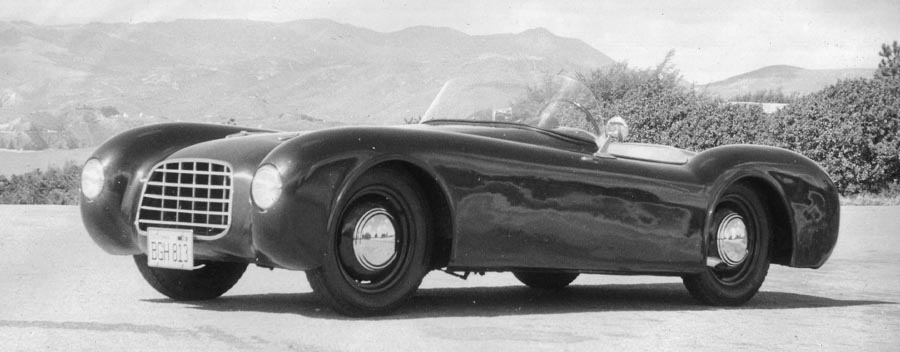
Hi Gang…
The best research often has nothing to do with effort or expertise. It often happens to just be plain old fashioned luck. That’s what happened to me when I was first contacted by Jules Heumann about a year ago concerning a beautiful special he built back in the mid 1950’s. Jules was just 28 years old in 1952 when he started his project based on a 1952 Singer 4AD Roadster. He wanted a sports car but there was little choice in his price range (and few sports cars to choose from) so he did what a special few enterprising young men did back then – he built it from scratch.
Jules was like many young men of the era. He wanted a sports car and he wanted something unique. 1952-1955 was the golden era of fiberglass sports cars, and Jules subscribed to Road and Track and no doubt read other publications as well. You couldn’t miss the number of custom built specials seen in those magazines back then, and like many guys from then, he chose to build it himself. When someone in the 1950’s decided to build themselves a car, they could choose to purchase an already built body by Glasspar, Victress, Allied or other company. Or….they could build it themself. Jules took the middle ground. More about that later.
Of course few people realize that the average time it took to build a sports car back then was approximately 2000 hours. That is, after you purchased your new fiberglass body and started from there. But Jules was braver than most and decided to design and build a body himself. This took him on a nearly 4 year trek modifying a chassis, creating a body, assembling it and finishing it off. Total time….just 3000 hours. And that was working after hours from his full time job, to boot!!!
3000 Hours of Excellence….
We often think of the episode in 1955 on the “You Asked It Video” which showed how to “Build a Sports Car in 4 Hours“. There could be nothing further from the truth. The agreed upon estimate back in the 1950’s was 2000 hours to build one of these cars. That’s a whole lot of sweat equity. A full time 40 hour a week year for 52 weeks is 2080 hours. If you put this in terms of an hourly rate today….let’s say $50 bucks an hour which is pretty reasonable…a nicely built car from the 1950’s would have taken 2000 hours or approximately $100,000 worth of labor to build the car. And this was before buying part #1. Jules estimated in an article back in 1958 that he spent 3000 hours building his car or in today’s terms about $150,000 worth of labor. This was a feat that few would tackle in today’s environment. Especially on his own and in his own garage – as Jules did back in 1952-1955.
Jules bought a wrecked 1952 Singer 4AD Roadster for $250 from an insurance company as his starting point. It had less than 2000 miles on it. He stripped and dumped the body, but kept the steering wheel, and little else other than the chassis and drivetrain. The car had a short wheelbase and small motor and both were important to him. He wanted a sports car, but not one with so much power it would be dangerous to drive. His choice of chassis was interesting because it was not the only Singer based special built around that time. BMC of San Francisco (Kjell Qvale) was building a special that debuted in fiberglass in 1952 – in the same area as Jules was building his car – and Singer in the UK debuted their first fiberglass bodied sports car on the same SMX chassis in 1953 (approximately 10 of these were made). Also, Glasspar worked with Vaughan-Singer Motors of Hollywood California to produce a special that was ultimately displayed at a show in the Northeast (Tritt shorted the Glasspar G2 body to fit). But none did it with the excellence of design, execution, and style as Jules did back then.
The Singer Roadster was produced by the Singer Motor Company from 1939 thru 1955, with the last model – the Singer 4AD Roadster, produced from 1951-1955. The 1952 Singer 4AD Roadster that Jules had chosen used a 48 horse power engine. Jules crafted the intake manifold himself. He modified the existing intake from fitting a single downdraft SU and created an intake manifold that would accept two carbs – 1 and 3/4 SU’s – same as the Jaguar from that period. The Motor Magazine (UK) reported that the single carb version in 1951 had a top speed of 73 miles an hour. With its lighter fiberglass body, Jules’ car most likely exceeded this figure to some extent because of additional carburetion.
The Singer was a good choice for a small car to build a special on. The body was easily removed from the chassis, and the chassis utilized independent coil spring front suspension, Lockheed style drum brakes with 9 inch drums (remember…small car here), and four speed gearbox with floor shifter. Those were some pretty nice features on a smaller type car. He started by moving the engine back and added a big cross brace to support the new engine location. He also dropped the engine by 2 and 3/4 inches. He still has the chassis drawing – 50 years later – and referenced the exact detail in conversation – so getting good info on his 1952-1955 build was fairly easy. He moved the rear springs from under the chassis to an outward position. Finally, he custom made the exhaust manifold – one of his most difficult tasks (he shared with me). Jules made no changes to the wheelbase of the Singer chassis – it remained 91 inches.
Next…what body to create? It just so happened he lived in the San Francisco Bay area and came in contact with Vale Wright – who built the Vale sports cars in the 1952/1953 era that was a near copy of the 1948 Cisitalia 202 Nuvolari Spyder.
Click here for more info about this Cisitalia
Jules somehow borrowed the molds from either Vale Wright or the company that produced them for Vale (Consolidated Plastics Inc, of Danville California) and set forth on a mission. Jules liked the car that Vale Wright was building – up to the rear tailfins. He wanted none of that.
Jules used the mold from the front of the car all the way to the back where the arch started for the rear wheels. Once he pulled this piece from the molds, he sectioned the newly created body to create a gentle slope to the rear wheels. Then, he used the front section of the mold again and took two more splashes. One was for the rear end itself, and the other was used to create sections to match up the front of the car (now sloped down toward the rear wheels) to the rear of the car. He did this at a time when all work was hand laid fiberglass. Chopper guns were something in the future. All coachbuilt hand laid glass here. (In talking with Jules, he couldn’t remember whether or not he started on the body in the same year as he started on the chassis – 1952. Typically, bodies were started some time after the chassis were started).
Jules made more changes to the body. He created a larger front opening than the Vale and custom built the grill to fit perfectly. He created a hood with a nicely designed hood scoop located over the carbs to help facilitate air intake, and created a rear opening hatch strictly for spare tire access. The taillights used appear to be 1949-1950 Pontiac. This was a very low slung car, and he decided that no doors would be best – and this would strengthen the entire body. He also custom made the dashboard and ran into a problem – no room for the tach. So…off to the junkyard Jules went, got a used bucket for a headlight, and molded a semicircle shape which fit above the steering wheel on the dashboard, and was perfectly shaped for the tachometer.
He brought the exhaust pipe out before the rear wheel on the driver’s side – very unusual at the time, and Jules thought it might have been one of the first cars to do this. Jules couldn’t figure out how to run the pipes past the rear axle properly, and this led to his solution above. Race cars had been doing this for years to reduce weight, and Jules was right in tune with this concept. A plastic boat windshield was used for the windscreen.
This project started in 1952 and Jules completed the car in 1955. It took nearly 4 years and over 3000 hours to finish. He used the car on a daily basis from 1955 thru 1958, but never took it to any shows, raced it, or left the Bay area with it. He was modest about his accomplishments but proud of its design and execution. To this day, he’s pleased with the overall design, but feels the back end of the car looks a bit “heavy” – primarily because he used the front end of the car as its starting point in design. He never named his car, so for our purposes, I’ve named it the “Jules Heumann Special” in the same way these cars were typically named back in the day.
He loved the way his special performed, and remarked recently that it handled very well for a sports car of its size. The car’s suspension was not stiff and thus offered a comfortable ride. It only appeared in one magazine – shown in the pictures below – the 1958 Custom Cars Annual Trend book.
As Jules recalls, the car did not have a convertible or removable hardtop. He remembers stopping at a traffic light one afternoon when it was raining and getting soaking wet. If you kept moving – you could keep dry. Stopping – not so lucky. “Well…a policeman on a motor cycle pulled up to the light and we both looked at each other – soaking wet – and burst out laughing. I still remember that to this day” said Jules.
He also remembers that the car was so close to the ground that he would pull up to stoplights and light a match on the ground – just at arm’s length. His best memory, though, was where he was going down a sidestreet and his way was blocked by a semi. Undaunted, Jules carefully and slowly drove under the center of the semi. Much to the amazement of both himself and the shipping clerk standing on the other side of the semi. Evidently, Jules was not just a builder…….but a stunt driver too.
Jules sold his car in the San Francisco Bay area in 1958 and bought a 1948 Jaguar Mark IV drophead. However, his custom built special was the start of his appreciation and enjoyment of beautifully designed and built sports cars.
The pictures below capture the build of the car from 1952 thru 1955 nicely. Jules is shown in two pictures (about age 28) sitting in the unfinished body of the car, and his brother Syl is shown sitting in the chassis of the car. Two of his daughters are seen in various pictures as well. Also included in the pictures below is the article the car appeared in.
Jules continued to pursue his car interest from the late 1950’s forward, and served for 30+ years as an advisor and later Chairman of the Pebble Beach Concours d’ Elegance through the late 1990’s. He now is Chairman Emeritus for the Pebble Beach Concours and is the recognized authority on Hispano-Suizas and Past President of the Hispano-Suiza Society.
Sadly J Heumann passed away in 2017
Click here for more information on his life and contribution to the automobile collector world
Maybe one of you out there has seen this beautifully built car. Jules would love to see his car again, and we would all be excited to see it too. The car was titled as a “Singer” and may still be recognized as a “Singer Special”. The challenge is out there to each of you to find this car and bring it home. It certainly deserves to be reunited with its builder of so many years ago. Perhaps the car is still in the Bay area today.
For those of you wishing to learn more about Singer cars of the 1940’s and 1950’s, here are two links:
Singer SM1500: http://en.wikipedia.org/wiki/Singer_SM1500
Singer Roadsters: http://en.wikipedia.org/wiki/Singer_Roadster
Geoff
Update 12/26/09: I found an a full page ad in Motor Trend, October 1953 showing a Singer Roadster and calling it an SM1500 – what Jules originally called his car. I wrote to the North American Singer Owner’s Group and got a detailed response to my question of whether it was a 4AD or SM1500. Here’s what Peter McKercher had to say (thanks Peter!): The 4AD and the SM 1500 are essentially the same car. The 4AD was originally introduced as a single carb car which was later given a second carb and a different rear end. I believe it was the latter that was referred to as the SM 1500C. Mike Rambour may be able to differentiate better. Only 3 or 4 SMX’s were built. Peter
| Technical Specifications | |
| Year | Built: 1952-1955 Finished: 1955 |
| Body | Modified Vale Wright Body (1948 Cisitalia 202 Nuvolari Spyder). Customized by Jules Heumann |
| Paint | Paint by shop in San Carlos. Dark Blue – Cadillac Dark Blue |
| Upholstery | Custom work by Jules Heumann – Light Blue |
| Frame | 1952 Singer 4AD Roadster |
| Suspension | Singer – see above |
| Engine (make/year) | 1952 Singer 4 cylinder SOHC (single overhead camshaft) |
| Displacement | 1497 cc |
| Carburetion | Custom made intake by Jules Heumann which accepted twin SU carbs – 2 and 3/4 bore (same as Jaguar) Custom made exhaust manifold by Jules Heumann |
| Horsepower (estimated) | 48 Horsepower |
| Transmission (type/year) | 4 speed manual on the floor (overdrive was an option but not installed here) |
| Rear Axle / driveshaft (open/closed driveshaft) |
Stock Singer – no changes |
| Wheelbase | 91 inches |
| Track/Tread (front/rear) (distance between center line of tires) |
Front 51 inches Rear 51 inches |
| Curb Weight | Estimated: 2000 lbs with fiberglass body (stock car with original body was around 2400 lbs) |
| Special Features | Custom built over 4 year period by Jules Heumann. A car tested by The Motor magazine in 1951 had a top speed (48 HP) of 73 mph (117 km/h) and could accelerate from 0-60 mph (97 km/h) in 23.6 seconds. A fuel consumption of 25.8 miles per imperial gallon (10.9 L/100 km; 21.5 mpg-US) was recorded. |
- 28 Year Old Jules Heumann at the Helm of His Special
- Jules Brother “Syl” at the Wheel
- Molds Were Used From Vale Wright’s Car Above
- The Finished Product: 1955 Jules Heumann Special

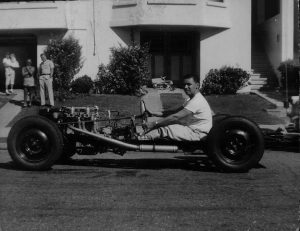
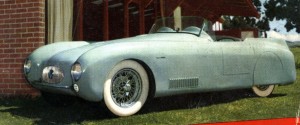
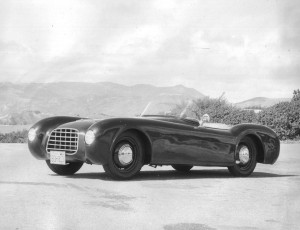


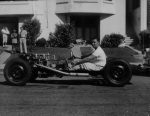
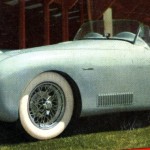
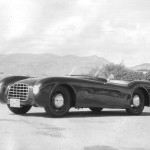
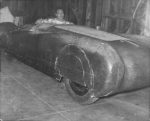
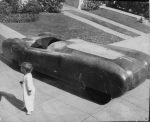
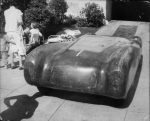
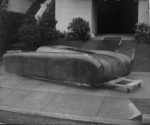
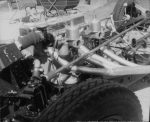
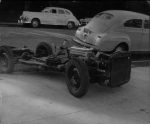
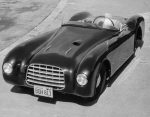
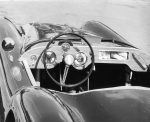
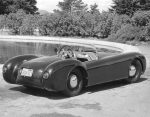
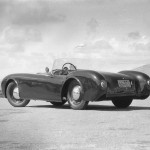
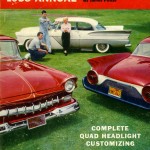
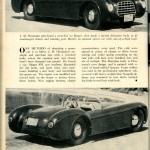

Interesting, Singer Specials could be made hotter by tweaking the engines and reducing the weight but the big drawback to the cars was braking and brake fade.